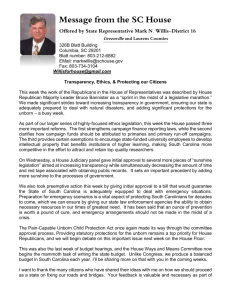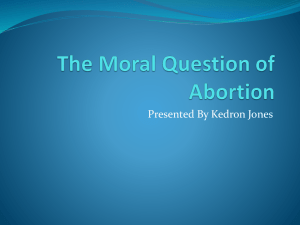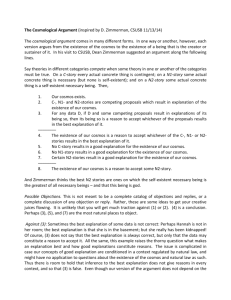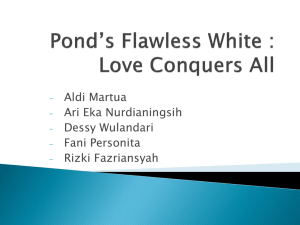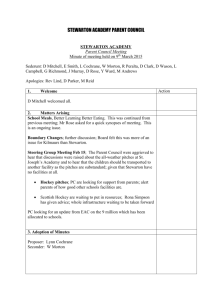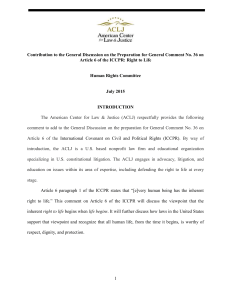This text is also avaliable as a word document click here to
advertisement
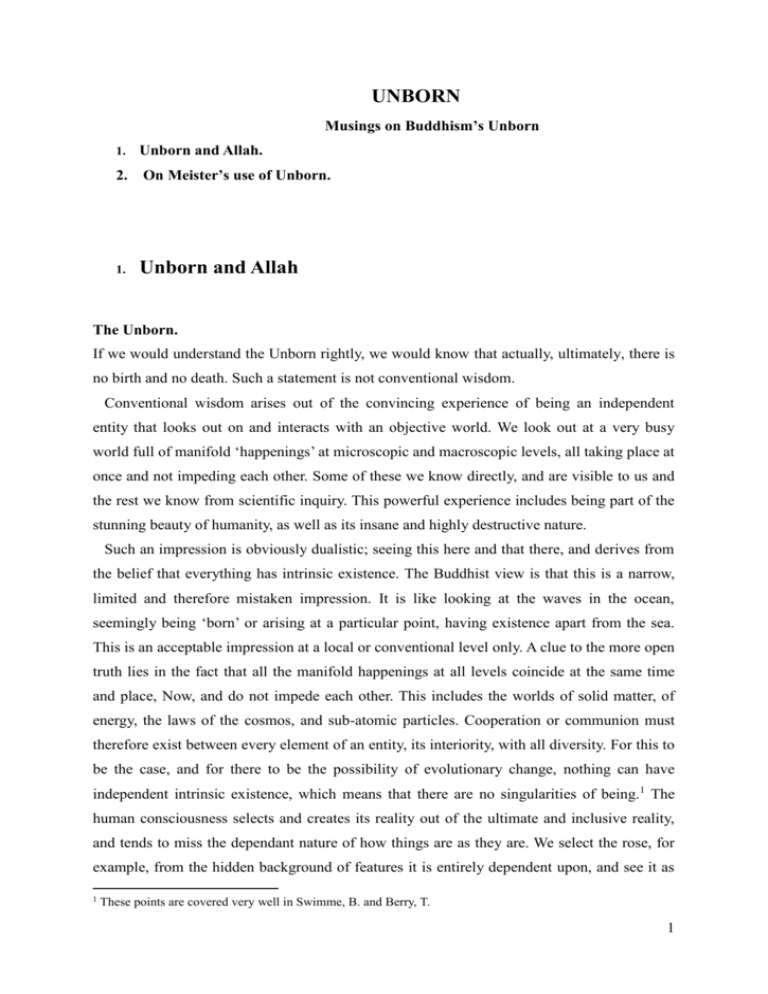
UNBORN Musings on Buddhism’s Unborn 1. Unborn and Allah. 2. On Meister’s use of Unborn. 1. Unborn and Allah The Unborn. If we would understand the Unborn rightly, we would know that actually, ultimately, there is no birth and no death. Such a statement is not conventional wisdom. Conventional wisdom arises out of the convincing experience of being an independent entity that looks out on and interacts with an objective world. We look out at a very busy world full of manifold ‘happenings’ at microscopic and macroscopic levels, all taking place at once and not impeding each other. Some of these we know directly, and are visible to us and the rest we know from scientific inquiry. This powerful experience includes being part of the stunning beauty of humanity, as well as its insane and highly destructive nature. Such an impression is obviously dualistic; seeing this here and that there, and derives from the belief that everything has intrinsic existence. The Buddhist view is that this is a narrow, limited and therefore mistaken impression. It is like looking at the waves in the ocean, seemingly being ‘born’ or arising at a particular point, having existence apart from the sea. This is an acceptable impression at a local or conventional level only. A clue to the more open truth lies in the fact that all the manifold happenings at all levels coincide at the same time and place, Now, and do not impede each other. This includes the worlds of solid matter, of energy, the laws of the cosmos, and sub-atomic particles. Cooperation or communion must therefore exist between every element of an entity, its interiority, with all diversity. For this to be the case, and for there to be the possibility of evolutionary change, nothing can have independent intrinsic existence, which means that there are no singularities of being.1 The human consciousness selects and creates its reality out of the ultimate and inclusive reality, and tends to miss the dependant nature of how things are as they are. We select the rose, for example, from the hidden background of features it is entirely dependent upon, and see it as 1 These points are covered very well in Swimme, B. and Berry, T. 1 intrinsically existing. As normally we favour our relative reality strongly, the ultimate dimension remains hidden from us. To release ourselves from the limitations of relative reality it is necessary to understand the dependant nature of phenomena. Nothing can exist by itself alone, and is only what it is in dependence upon other things. We can see that things are made up of, are dependent on, their component parts. If the component parts are looked into nothing will be found that we can point to and identify as the essential nature of the ‘thing’, as its defining characteristic. Things come to be known as they are by designation; it is we who name the rose, for example. So all phenomena are conceptual labels applied to aggregations of other factors. If the rose is penetrated in this way its total dependency on climatic, mineral, microbial and situational aspects which include the action of insects, and much more perhaps, will be seen. The rose, then, is a rose at the conventional level; in its complete reality it is not a rose, and it is this fact that means it is a rose.2 As nothing has its existence without everything else, it has no intrinsic nature; it is void of ‘self-nature’ and is said to be ‘empty’ in Buddhism. Anything that has arisen in dependence on other things is unborn. Not being born, it cannot die. Once again, the rose in its ultimate reality is void of ‘self-nature’, is ‘empty’, and only being what it is in interbeing with the universe, is unborn. Our consciousness gives it birth as a rose, and only in this narrow, relative sense has it birth and death. Our everyday world is heavily based on memories of what has already occurred, and the language we use and concepts that define our reality tend to be on the basis of an anticipated future. Clearly a strong sense of self is involved in this, so that once any sense contact is made, a conception of and identification with the object takes place. The reality created in this way is our own relative reality, and the more complete truth, the unborn, recedes. An appreciation of the unborn can be had when we can simply note the sense contact before conceptualisation takes place, and before the consequent positive or negative emotional or feeling tone. Such awareness will allow us to see the arising and passing away of phenomena, with a greater appreciation of emptiness. We can then take account of the ultimate reality in our conventional lives. In the Buddhist view emptiness characterises everything in the cosmos, which is to say that whatever our experience tells us about an objective, dualistic world, everything is instead oneness; everything implying and confirming everything else, and having no reality apart 2 This is the logic of Soku-hi mentioned below. 2 from everything else. The boundaries that we conventionally place between one entity and another, one being from another and one thought from another are erroneous; everything is everything; everything at once. The conventional reality of the rose is qualified by human consciousness, and its ultimate reality, the unborn, ‘operates’ as all the ‘dimensions’ that bring the rose about. The reality created by human consciousness, therefore, is equally the operation of the unborn. If the rose is so because of designation, and is not so otherwise, then we have a situation of ‘Yes’ and ‘No’, with the rose being a boundary between the two. The ‘Yes’/’No’ being identical, the two move in unison.3 Similarly, in Islam ‘Allah’ can be regarded as the ‘ultimate force behind being and nothingness, which includes the most mysterious concept: Holy absence, the ‘No’ (La) that balances the ‘Yes’ (Al)’4 with the two moving in unison together. The next section will take a look at how Sufi Ibn ‘Arabi talks of ‘boundary’. The Unborn and Allah. Ibn ‘Arabi taught extensively on the mysterious concept of Yes/No; on how the many are one and the one many, what is true reality and what is mistaken. For Ibn ‘Arabi the Cosmos, Unity or Oneness, the Real, is the only true reality, with the diversity of phenomena being utterly dependent on the Real, and having no independent reality of their own; phenomena are poor towards the Real. The Cosmos consists of non-existent meanings manifest in the Real, and are nothing but what he calls ‘imagination’. So everything is in a state of being true/not true, or as Ibn ‘Arabi puts it ‘He/not He: ‘The Real manifest through form is He/not He. He is the limited who is not limited, the seen who is not seen.’5 Mistaken perception regards the visible world as individual and separate parts, but the wise, the Folk of Allah says Ibn ‘Arabi, see that looking at any one thing leads on to another in infinite interrelationship. To see phenomena in this way avoids the danger of thinking of the Cosmos, or Oneness as a static state. However, Being, Oneness or the Cosmos as such is unchanging, whereas that which is the expression of Oneness, multiplicity, is in constant flux. Taking ‘Being’ alone allows of no multiplicity, yet when multiplicity is looked at, the variety of diversity indicates that in any given moment each entity fluctuates, transforms and transmutates. This means that ‘each new state, each changed situation, is a newly created possible thing, similar to the first, but not identical’. This is the logic of Soku-hi. See Takemura and Suzuki volume 13 Pp 274/5. Douglas-Klotz, N. 1995, P 15. 5 Chittick, P 116. 3 4 3 Here we have an important concept for Ibn ‘Arabi, that of perpetual creation, of ever-new creation. Criticising a particular sect’s incomplete understanding of perpetual creation he wrote that ‘They did not understand that the whole cosmos is a collection of accidents, hence it undergoes continual change (tabaddul) at every moment, since ‘The accident does not remain for two moments’’ (Fusus 125). Consequently, he writes: ‘…in every instant (nafas) the cosmos in respect of its form undergoes a new creation in which there is no repetition.’6 Hence: …no state can remain for two moments, since, were it to remain for two moments, the Real would not be the creator of that thing in which the state remained. It would not be poor toward God and would be qualified by independence from Him. But this is impossible.7 This constant agitation reflects the relationship between God and nothingness which is made possible by the barzakh, which is the condition of lying between the two. Every entity is a barzakh. Without the barzakh God would be incomparable, and there would be no creation. Barzakh brings the Cosmos into existence and allows us to speak of His similarity to the creatures and the creatures’ similarity to Him. Otherwise there would be no creation.8 At this point it should be clarified that creation here is not the common impression of a temporal act – God first, then creation - but instead means, according to Hamadani, ‘a metaphysical region where there is, or there can be, no temporal order between things and where everything is divested of its temporal nature’.9 There is then, the Cosmos, which as a concept is more clearly stated as being Unity, or Oneness. It has no reality apart from multiplicity, so phenomena do not come from Unity, nor do they return to Unity; there is only Unity. The Cosmos is a dynamic relationship, an interbeing of every entity in communion with all diversity. In interbeing nothing is of itself alone, yet at the same time every seemingly single thing is everything, and we can agree with Mohammad Lahiji: ...you will be able to see that the entire creation and all things in it are parts of yourself, that you penetrate every molecule of everything, and that there is nothing Ibid, P 97 Ibid, P 99. 8 Ibid, P 181. 9 Izutsu, T. 1977, P.128. 6 7 4 outside of 'you'. Thus you understand that there exists nothing outside of your 'I'.10 It is the case then that the Cosmos reveals itself in every form, and when the Cosmos is referred to as God, we can say that God’s love is revealed in every form; it is not that God as a noun loves us as objects; we are God’s love. Everyday life is consequently an expression of love as an ontological reality, and we cannot avoid such service. When we can recognise this we can live as a Buddhist would recommend, with: unconditional and impartial compassion; unconditional and impartial loving kindness; joy in the being of others; and serenity in the oneness of things. Such a way of living is the whole point of going into the matter dealt with in this short essay. Bibliography. Chittick, William. The Sufi Path of Knowledge. (SUNY 1989) Douglas-Klotz, N. Desert Wisdom. (Harper Collins, 1995) Izutsu, Toshihiko, ‘The Concept of Perpetual Creation in Islamic Mysticism and Zen Buddhism’, in Melanges Offerts a Henri Corbin, (Ed) Seyyed Hossein Nasr, (Tehran, 1977). Shabistari, Mahmood. Garden of Mystery. (Trans) Robert A.H. Darr. (Archetype, 2007). Suzuki D.T. The Collected Works of D.T. Suzuki. (Tokyo: Iwanami Shoten) Swimme, B. and Berry, T. The Universe Story. (Harper and Collins 1992) Takemura, M. ‘Zen and Pure Land’ The Eastern Buddhist Society Magazine xxxiv (2). 10 Shabistari, M. Darr, R.A.H., trans. 5
